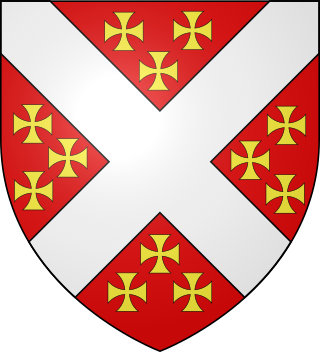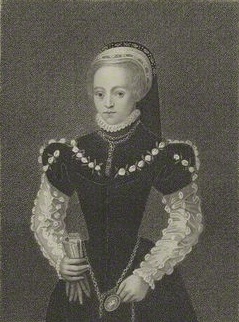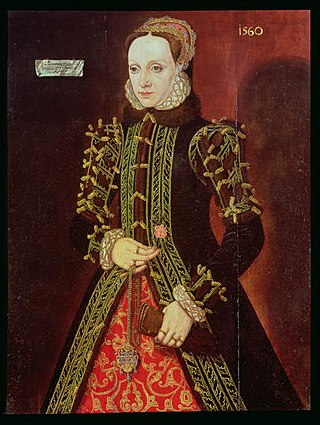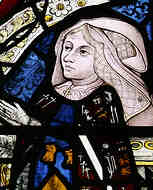Related Research Articles

Catherine Parr was Queen of England and Ireland as the last of the six wives of King Henry VIII from their marriage on 12 July 1543 until Henry's death on 28 January 1547. Catherine was the final queen consort of the House of Tudor, and outlived Henry by a year and eight months. With four husbands, she is the most-married English queen. She was the first woman to publish in print an original work under her own name in England in the English language.

Thomas Seymour, 1st Baron Seymour of Sudeley, KG, PC was a brother of Jane Seymour, the third wife of King Henry VIII. With his brother, Edward Seymour, 1st Duke of Somerset and Lord Protector of England, he vied for control of their nephew, the young King Edward VI. In 1547, Seymour married Catherine Parr, the widow of Henry VIII. During his marriage to Catherine, Seymour involved the future Queen Elizabeth I, who resided in his household, in flirtatious and possibly sexual behaviour.

Sir Anthony Denny was Groom of the Stool to King Henry VIII of England, thus his closest courtier and confidant. In 1539 he was appointed a gentleman of the privy chamber and was its most prominent member in King Henry's last years, having together with his brother-in-law, John Gates, charge of the "dry stamp" of the King's signature, and attended the King on his deathbed. He was a member of the Reformist circle that offset the conservative religious influence of Bishop Gardiner. He was a wealthy man, having acquired several manors and former religious sites distributed by the Court of Augmentations after the Dissolution of the Monasteries.

Anne Seymour, Duchess of Somerset was the second wife of Edward Seymour, 1st Duke of Somerset, who held the office of Lord Protector during the first part of the reign of their nephew King Edward VI. The Duchess was briefly the most powerful woman in England. During her husband's regency she unsuccessfully claimed precedence over the queen dowager, Catherine Parr.

In common parlance, the wives of Henry VIII were the six Queens consort of King Henry VIII of England between 1509 and his death in 1547. In legal terms, Henry had only three wives, because three of his marriages were annulled by the Church of England. He was never granted an annulment by the Pope as he desired, for Catherine of Aragon, his first wife. Annulments declare that a true marriage never took place, unlike a divorce, in which a married couple end their union. Along with his six wives, Henry took several mistresses.

Nicholas Vaux, 1st Baron Vaux of Harrowden was a soldier and courtier in England and an early member of the House of Commons. He was the son of Lancastrian loyalists Sir William Vaux of Harrowden and Katherine Penyson, a lady of the household of Queen Margaret of Anjou, wife of the Lancastrian king, Henry VI of England. Katherine was a daughter of Gregorio Panizzone of Courticelle, in Piedmont, Italy which was at that time subject to King René of Anjou, father of Queen Margaret of Anjou, as ruler of Provence. He grew up during the years of Yorkist rule and later served under the founder of the Tudor dynasty, Henry VII.

William Herbert, 1st Earl of Pembroke, 1st Baron Herbert of CardiffKG PC was a Welsh Tudor period nobleman, politician, and courtier.

Katherine Ashley, also known as Kat Ashley or Astley, was the first close friend, governess, and Lady of the Bedchamber to Queen Elizabeth I of England. She was the aunt of Catherine Champernowne, who was the mother of Sir Humphrey Gilbert from her first marriage and Sir Walter Raleigh by her second marriage.
Margaret Bryan, Baroness Bryan was lady governess to the children of King Henry VIII of England, the future monarchs Mary I, Elizabeth I, and Edward VI, as well as the illegitimate Henry FitzRoy. The position of lady governess in her day resembled less that of the popular modern idea of a governess, more that of a nanny.

Sir Thomas Parr of Kendal in Westmorland, England, was a courtier and is best known as the father of Queen Catherine Parr, the sixth and final wife of King Henry VIII.
Anne Basset was an English lady-in-waiting of the Tudor period, reputed to have been the mistress of King Henry VIII.

Maud Green, Lady Parr was an English courtier. She was the mother of Catherine Parr, the sixth wife of King Henry VIII of England. She was a close friend and lady-in-waiting to Catherine of Aragon. She was also co-heiress to her father, Sir Thomas Green of Green's Norton in Northamptonshire along with her sister, Anne, Lady Vaux.

Anne Herbert, Countess of Pembroke, Baroness Herbert of Cardiff was lady-in-waiting to each of Henry VIII of England's six wives. She was the younger sister of his sixth wife, Catherine Parr.

Elizabeth FitzGerald, Countess of Lincoln, also known as "The Fair Geraldine", was an Irish noblewoman and a member of the celebrated FitzGerald dynasty. She became the second wife of Sir Anthony Browne and later the third wife of English admiral Edward Clinton, 1st Earl of Lincoln. She was the inspiration for The Geraldine, a sonnet written by Henry Howard, Earl of Surrey.

Elizabeth Tilney, Countess of Surrey was an English heiress who became the first wife of Thomas Howard, 2nd Duke of Norfolk. She served successively as a lady-in-waiting to two Queen consorts, namely Elizabeth Woodville, wife of King Edward IV, and later as Lady of the Bedchamber to that Queen's daughter, Elizabeth of York, the wife of King Henry VII. She stood as joint godmother to Princess Margaret Tudor at her baptism.

Dorothy Bray, Baroness Chandos was an English noblewoman, who served as a Maid of Honour to three queens consort of King Henry VIII of England; Anne of Cleves, Catherine Howard, and Catherine Parr. From 1541 to 1543, she had an affair with the latter's married brother, William Parr, 1st Marquess of Northampton.
Lord John Grey was an English nobleman and courtier of the Tudor period, who after 1559 was seated at Pirgo Place in Essex.
Elizabeth FitzHugh also known as Lady Elizabeth Parr. She was an English noblewoman and lady-in-waiting to her cousin, Anne Neville, queen consort of King Richard III. She was grandmother of Catherine Parr, sixth queen consort to King Henry VIII, and her siblings Anne Herbert, Countess of Pembroke, and William Parr, 1st Marquess of Northampton.
Alice Neville, Baroness FitzHugh or Lady Alice FitzHugh, was the wife of Henry FitzHugh, 5th Baron FitzHugh. She is best known for being the great-grandmother of queen consort Catherine Parr and her siblings, Anne and William, as well as one of the sisters of Warwick the 'Kingmaker'. Her family was one of the oldest and most powerful families of the North. They had a long-standing tradition of military service and a reputation for seeking power at the cost of the loyalty to the crown as was demonstrated by her brother, the Earl of Warwick.
Elizabeth Tyrwhitt, was an English gentlewoman, courtier, and writer.
References
- ↑ Women’s Bookscapes in Early Modern Britain: Reading, Ownership, Circulation. (2018). USA: University of Michigan Press.
- ↑ Weir, A. (2018). Six Tudor Queens: Jane Seymour, The Haunted Queen: Six Tudor Queens 3. Storbritannien: Headline.
- ↑ The Last Days of Henry VIII by Robert Hutchinson, p. 154
- ↑ Hart, K. (2010). The Mistresses of Henry VIII. Storbritannien: History Press.
- ↑ Henry Ellis, Original Letters, series 1 vol. 2 (London, 1824), pp. 126-127.
- ↑ Mosley, Charles, editor. Burke's Peerage, Baronetage & Knightage, 107th edition, 3 volumes (Wilmington, Delaware, U.S.A.: Burke's Peerage (Genealogical Books) Ltd, 2003), Volume I, pg. 1094.